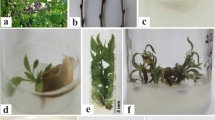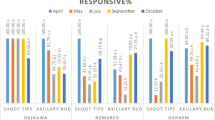Abstract
In vitro propagation is a useful method for clonal propagation of apricot; however, it is a highly genotype-dependent procedure. Eight different experiments were conducted to optimize and establish an efficient in vitro propagation protocol for three Iranian apricot cultivars, including Ordubad, Shams, and Qaysi. Sterilization, in vitro establishment, proliferation, root induction, and acclimatization steps were assessed. The fungal and bacterial infections were significantly decreased when nanosilver (2.5%) was applied in sterilization of initial explants. The highest number of active buds was obtained from summer-season collected lateral bud explants. The establishment responses of apricot cultivars to investigated basal culture media were different and the best results for Ordubad, Shams, and Qaysi cultivars were obtained from Driver and Kuniyuki (DKW), Woody Plant Medium (WPM), and modified Quoirin and Lepoivre (QL) basal media, respectively. The highest number of induced lateral shoots in Ordubad cultivar (2.33) was obtained from basal QL medium supplemented with BAP (4.44 μmol L−1), GA3 (1.44 μmol L−1), and IBA (0.098 μmol L−1). In Shams and Qaysi cultivars, the highest numbers of induced lateral shoots were obtained from WPM basal medium. The best combinations of BAP and GA3 hormones to increase the number of induced lateral shoots in three Iranian apricot cultivars were 11.56 μmol L−1 GA3 and 4.44 μmol L−1 BAP. In comparison with routine solid culture system, a 10 min h−1 temporary immersion bioreactor system led to the significant increase of the number of induced lateral shoots, with higher shoot quality, in all investigated cultivars. The half strength QL medium supplemented with 19.68 μmol L−1 of IBA resulted in the highest rooting percentage in all investigated apricot cultivars. The results of the present study would be applicable for cost-effective large-scale clonal propagation of other valuable cultivars of apricot.




Similar content being viewed by others
References
Amiri S, Panahi B, Mohammadi R, Fattahi F (2019) Effect of plant growth regulator combination on direct in vitro regeneration of Persian Lilac (Melia azedarach L.). Proc Natl Acad Sci India B 1-5. https://doi.org/10.1007/s40011-019-01099-5
Benelli C, De Carlo A (2018) In vitro multiplication and growth improvement of Olea europaea L. cv Canino with temporary immersion system (Plantform™). 3. Biotech 8:317–321. https://doi.org/10.1007/s13205-018-1346-4
Bulbarela-Marini JE, Gómez-Merino FC, Galindo-Tovar ME, Solano-Rodríguez LA, Murguía-González J, Pastelín-Solano MC, Núñez-Pastrana R, Castañeda-Castro O (2019) The in vitro propagation system of Citrus× latifolia (Yu. Tanaka) Yu. Tanaka (Rutaceae) affects the growth and depletion of nutriments. In Vitro Cell Dev Biol – Plant 55:290–295. https://doi.org/10.1007/s11627-019-09976-4
Burgos L, Alburquerque N (2003) Ethylene inhibitors and low kanamycin concentrations improve adventitious regeneration from apricot leaves. Plant Cell Rep 21:1167–1174. https://doi.org/10.1007/s00299-003-0625-6
Carmona-Martin E, Petri C (2020) Adventitious regeneration from mature seed-derived tissues of Prunus cerasifera and Prunus insititia. Sci Hortic 259:1–6. https://doi.org/10.1016/j.scienta.2019.108746
Cati M, Gennari F, Marino G (2014) Effect of culture jar seal on in vitro rooting and subsequent acclimatization of three Italian apricot varieties. Sci Hortic 168:120–123. https://doi.org/10.1016/j.scienta.2014.01.026
Cui Y, Deng Y, Zheng K, Hu X, Zhu M, Deng X, Xi R (2019) An efficient micropropagation protocol for an endangered ornamental tree species (Magnolia sirindhorniae Noot. & Chalermglin) and assessment of genetic uniformity through DNA markers. Sci. Rep 9:1–10. https://doi.org/10.1038/s41598-019-46050-w
de Freitas RT, Paiva R, Campos NA, Silva LC, Swennen RL, Panis B (2016) In vitro culture of Annona emarginata: A rootstock for commercial annonaceae species. Plant Cell Culture Micropropagation 12:1–6
da Silva Teixeira JA, Kulus D, Zhang X, Zeng S, Ma G, Piqueras A (2016) Disinfection of explants for saffron (Crocus sativus L.) tissue culture. Environ Exp Bot 14:183–198. https://doi.org/10.22364/eeb.14.25
Driver JA, Kuniyuki AH (1984) In vitro propagation of Paradox walnut rootstock. HortScience 19:507–509
FAO (2020) Food and Agriculture Organization of the United Nations. www.fao.org.
Farag KM, Nagy NM, Soliman HI, Ahmed ME (2012) In vitro propagation of apricot (Prunus armeniaca L.) growing at Saint Catherine valleys in Sinai peninsula, Egypt. J Agric Env Sci DamUniv Egypt 11:1–35
Gago J, Pérez-Tornero O, Landín M, Burgos L, Gallego PP (2011) Improving knowledge of plant tissue culture and media formulation by neurofuzzy logic: a practical case of data mining using apricot databases. J Plant Physiol 168:1858–1865. https://doi.org/10.1016/j.jplph.2011.04.008
Gamborg OL, Miller R, Ojima K (1968) Nutrient requirements of suspension cultures of soybean root cells. Exp. Cell Res 50:151–158. https://doi.org/10.1016/0014-4827(68)90403-5
Hesami M, Daneshvar MH, Yoosefzadeh-Najafabadi M, Alizadeh M (2018) Effect of plant growth regulators on indirect shoot organogenesis of Ficus religiosa through seedling derived petiole segments. Genet Eng Biotechn N 16:175–180. https://doi.org/10.1016/j.jgeb.2017.11.001
Hesami M, Naderi R, Tohidfar M (2019) Modeling and optimizing in vitro sterilization of Chrysanthemum via multilayer perceptron-non-dominated sorting genetic algorithm-II (MLP-NSGAII). Plant Sci 10:1–13. https://doi.org/10.3389/fpls.2019.00282
Iliev I, Gajdoˇsova A, Libiaková G, Jain SM, (2010) Plant micropropagation. In: R. Davey, Anthony MP (eds). Plant Cell Culture: Essential Methods. UK: John Wiley & Sons 1-23.
Khalili S, Niazian M, Arab M, Norouzi M (2020) In vitro chromosome doubling of African daisy, Gerbera jamesonii Bolus cv. Mini Red. Nucleus 63:59–65. https://doi.org/10.1007/s13237-019-00282-3
Khatri P, Rana JS, Sindhu A, Jamdagni P (2019) Effect of additives on enhanced in-vitro shoot multiplication and their functional group identification of Chlorophytum borivilianum Sant. Et Fernand. SN Appl Sci 1:1–10. https://doi.org/10.1007/s42452-019-1118-8
Koubouris G, Vasilakakis M (2006) Improvement of in vitro propagation of apricot cultivar ‘Bebecou’. Plant Cell Tiss Org Cult 85:173–180. https://doi.org/10.1007/s11240-005-9066-y
Kovalchuk IY, Mukhitdinova Z, Turdiyev T, Madiyeva G, Akin M, Eyduran E, Reed BM (2017) Modeling some mineral nutrient requirements for micropropagated wild apricot shoot cultures. Plant Cell Tiss Org Cult 129:325–335. https://doi.org/10.1007/s11240-017-1180-0
Kovalchuk IY, Mukhitdinova Z, Turdiyev T, Madiyeva G, Akin M, Eyduran E, Reed BM (2018) Nitrogen ions and nitrogen ion proportions impact the growth of apricot (Prunus armeniaca) shoot cultures. Plant Cell Tiss Org Cult 133:263–273. https://doi.org/10.1007/s11240-018-1379-8
Kudělková M, Pavelková R, Ondrušiková E, Vachůn M (2017) The issues of apricot (Prunus Armeniaca L.) micropropagation. Acta Universitatis Agriculturae et Silviculturae Mendelianae Brunensis 65:67–72. https://doi.org/10.11118/actaun201765010067
Lloyd G, McCown B (1980) Commercially-feasible micropropagation of mountain laurel, Kalmia latifolia, by use of shoot-tip culture. Comb Proc Int Plant Prop SOC 30:421–427
Lozzi A, Abdelwahd R, Mentag R, Abousalim A (2019) Development of a new culture medium and efficient protocol for in vitro micropropagation of Ceratonia siliqua L. In Vitro Cell Dev Biol – Plant 55:615–624. https://doi.org/10.1007/s11627-019-09990-6
Marino G, Magnanini E, Battistini S, Righetti B (1991) Effect of Hormones and Main Carbon Energy Sources on In Vitro Propagation of Apricot (Prunus armeniaca L.) cvs. ‘San Castrese’ and ‘Portici’. Acta Hort 79(2):335–362. https://doi.org/10.17660/ActaHortic.1991.293.42
Murashige T, Skoog F (1962) A revised medium for rapid growth and bio assays with tobacco tissue cultures. Physiol Plant 15:473–497. https://doi.org/10.1111/j.1399-3054.1962.tb08052.x
Nasri A, Baklouti E, Romdhane AB, Maalej M, Schumacher HM, Drira N, Fki L (2019) Large-scale propagation of Myrobolan (Prunus cerasifera) in RITA® bioreactors and ISSR-based assessment of genetic conformity. Sci Hortic 245:144–153. https://doi.org/10.1016/j.scienta.2018.10.016
Niazian M (2019) Application of genetics and biotechnology for improving medicinal plants. Planta 249:953–973. https://doi.org/10.1007/s00425-019-03099-1
Niazian M, Noori SAS, Galuszka P, Tohidfar M, Mortazavian SMM (2017) Genetic stability of regenerated plants via indirect somatic embryogenesis and indirect shoot regeneration of Carum copticum L. Ind Crop Prod 97:330–337. https://doi.org/10.1016/j.indcrop.2016.12.044
Niazian M, Sadat-Noori SA, Abdipour M, Tohidfar M, Mortazavian SMM (2018) Image processing and artificial neural network-based models to measure and predict physical properties of embryogenic callus and number of somatic embryos in ajowan (Trachyspermum ammi (L.) Sprague). In Vitro Cell Dev Biol – Plant 54:54–68. https://doi.org/10.1007/s11627-017-9877-7
Niazian M, Shariatpanahi ME, Abdipour M, Oroojloo M (2019) Modeling callus induction and regeneration in an anther culture of tomato (Lycopersicon esculentum L.) using image processing and artificial neural network method. Protoplasma 256:1317–1332. https://doi.org/10.1007/s00709-019-01379-x
Pérez-Tornero O, Burgos L (2000) Pérez-Tornero O, Burgos L (2000) Different media requirements for micropropagation of apricot cultivars. Plant Cell Tiss Org Cult 63:133–141. https://doi.org/10.1023/A:1006430718024
Pérez-Tornero O, Egea J, Vanoostende A, Burgos L (2000a) Assessment of factors affecting adventitious shoot regeneration from in vitro cultured leaves of apricot. Plant Sci 158:61–70. https://doi.org/10.1016/S0168-9452(00)00303-4
Pérez-Tornero O, Lopez JM, Egea J, Burgos L (2000b) Effect of basal media and growth regulators on the in vitro propagation of apricot (Prunus armeniaca L.) cv. Canino. J Hortic Sci Biotechnol 75:283–286. https://doi.org/10.1080/14620316.2000.11511238
Quoirin M, Lepoivre P (1977) Etude de milieux adaptes aux cultures in vitro de Prunus. Acta Hortic 78:437–442
Rugini E (1984) In vitro propagation of some olive (Olea europaea sativa L.) cultivars with different root-ability, and medium development using analytical data from developing shoots and embryos. Sci Hortic 24:123–134. https://doi.org/10.1016/0304-4238(84)90143-2
Ruiz D, Martínez-Gómez P, Rubio M, Petri C, Larios A, Campoy JA, Egea J (2011) Application of biotechnology tools to apricot breeding. Fruit Vegetable Cereal Sci Biotech 5:101–117
van der Salm TP, van der Toorn CJ, Bouwer R, ten Cate CHH, Dons HJ (1997) Production of ROL gene transformed plants of Rosa hybrida L. and characterization of their rooting ability. Mol Breed 3:39–47. https://doi.org/10.1023/A:1009617704014
van der Salm TP, Van der Toorn CJ, ten Cate CHH, Dubois LA, De Vries DP, Dons HJ (1994) Importance of the iron chelate formula for micropropagation of Rosa hybrida L.‘Moneyway’. Plant Cell Tiss Org Cult 37:73–77. https://doi.org/10.1007/BF00048120
Vaghari-Azar E, Vatanpour-Azghandi A, Majidi-Heravan E, Dejampour J, Habashi AA (2012) Micropropagation of two apricot× plum inter specific hybrid rootstocks (HS405 and HS706). Iran J Genet Plant Bred 1:9–15
Vidal N, Sánchez C (2019) Use of bioreactor systems in the propagation of forest trees. Eng Life Sci 19:896–915. https://doi.org/10.1002/elsc.201900041
Wen SS, Chen L, Tian RN (2019) Micropropagation of tree peony (Paeonia sect. Moutan): A review. Plant Cell Tiss Org Cult 141:1–14. https://doi.org/10.1007/s11240-019-01747-8
Yildirim H, Ahmet ONAY, Tilkat E, Akturk Z (2011) Micropropagation of the apricot (Prunus armeniaca L.) cv. Hacıhaliloğlu by means of single node culture. Turk J Agric For 35:55–64. https://doi.org/10.3906/tar-0904-2
Author information
Authors and Affiliations
Corresponding author
Additional information
Editor: Jorge Canhoto
Rights and permissions
About this article
Cite this article
Zare Khafri, A., Solouki, M., Zarghami, R. et al. In vitro propagation of three Iranian apricot cultivars. In Vitro Cell.Dev.Biol.-Plant 57, 102–117 (2021). https://doi.org/10.1007/s11627-020-10112-w
Received:
Accepted:
Published:
Issue Date:
DOI: https://doi.org/10.1007/s11627-020-10112-w




